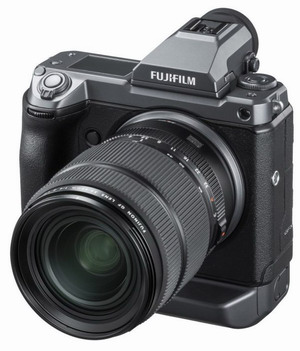Pues en realidad lo que ha hecho el muy cuco es comentar sus especificaciones y poner los apartados típicos de sus análisis, pero no hay ni una sola muestra. Yo creo que ni la ha tocado.
Aún así, como sus apartados clásico, tiene cierto interés y además en este caso son muy extensos, los pongo aquí por si os apetece echarles un vistazo.
El presunto análisis está aquí.
Y lo que dice es esto:
New since 2018’s GFX 50R:
- 100 megapixels.
- 5 FPS.
- In-body sensor-shift image stabilization.
- Full-frame phase-detection autofocus.
- 2,160,000 autofocus points.
- Voice memos, just like every pro DSLR (D5, 1DX Mk II etc.) for note-taking as you shoot.
- 5,760,000 dot removable OLED finder.
- Detachable electronic viewfinder with optional pivoting mount:
- Huge 0.87x finder magnification, world’s largest.
- Second rear data-only OLED.
- Big monoblock dual-battery grip with full vertical controls (grip doesn’t come off).
- Grip/camera holds and comes with two NP-T125 Li-Ion batteries rated for 800 shots together!
- Skin-smoothing mode.
- Double-exposure mode, with overlaid preview.
- 16-bit raw.
- 4K/30p 10-bit F-Log Rec 2020 uncompressed 4:2:2 video via HDMI.
- No more shutter speed, ISO or exposure compensation dials — but who uses those?
Good:
- Superb medium-format image quality. No full frame camera matches the GFX 100’s high-ISO, noise and resolution performance at any price
- Two normal SD card slots.
- Comes with two Fujifilm NP-T125 batteries.
- Two Fujifilm NP-T125 battery slots.
- Both batteries rated for a whopping 800 shots together.
- Manual shutter speeds directly set all the way out to an hour, no need for a timer or remote release.
- Autofocus mode lever on the back of the camera, easily adjustable with your shooting thumb.
- 4:3 «Ideal Format» aspect ratio.
- Huge range of as-shot crop options: 3:2 Barnack’s Folly, 4:3 native, 4:5 large-format, 6:7 Mamiya, 1:1 Hasselblad square, 16:9 and 2.71:1 (65:24) panoramic and 24 × 36mm. Whew!
- Shutter buttons on an angle on the grip.
- Full duplicate set of controls for vertical use.
- Silent electronic shutter goes to 1/16,000.
- Numerous AF zones with automatic face and nearest-eye recognition.
- All the crazy film simulation and dynamic range modes of Fujifilm’s other cameras.
- Fujifilm View Camera Adapter G (or the more functional FotodioX Multi-Position Stitching Adapter that sells for half the price) let you attach this camera to the Graflok back of a 4 × 5″ view or press camera.
- Fujifilm Hasselblad Mount Adapter C adapts Hasselblad HC and HCD and Fujinon HC-mount lenses to the GFX. You won’t get autofocus, but you will get electronic aperture and in-lens shutter control (more about compatibility).
- Tethered USB shooting via Capture One.
- Fujifilm’s free X RAW STUDIO USB tethering software lets the camera’s dedicated superfast DSP hardware process the raw data instead of your computer, even for batch processing!
- Wi-Fi.
- Bluetooth Low Energy.
- Weather- and dust-resistant with 95 seals:
Bad:
- No shutter speed dial, the only serious Fujifilm camera without one. Epic failure!
- No exposure compensation dial. Epic failure!
- No ISO dial.
- No rear 4-way rear controller; use the nubbin instead.
- Big.
- Heavy.
- Expensive, but a bargain when you look at the per-pixel cost of under 1/100 cent per pixel.
Missing
- No shutter speed dial, the only serious Fujifilm camera without one. Epic failure!
- No exposure compensation dial. Epic failure!
- No ISO dial, Fuji put an LCD screen there instead.
- No rear 4-way rear controller; use the nubbin instead.
- Huge camera, but uses a tiny 3.2″ little LCD, like an APS-C camera. Geesh, even an iPhone 3GS from ten years ago has a bigger screen.
- No standard threaded cable release socket.
- No GPS or NFC.
- No built-in flash.
To be continued…………
En cuanto los gurús la tengan en sus manos la destriparán y nos lo explicarán todo.

